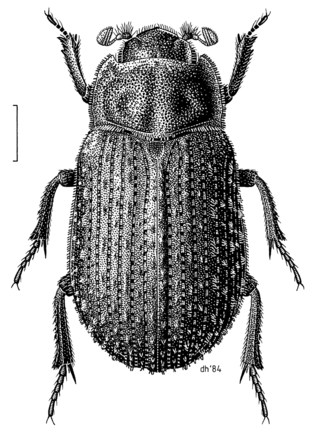
Trox scaber is a beetle of the family Trogidae. The 5 to 8 mm long insect is found worldwide, including in Europe, and lives in bird nests.

Leptostylopsis annulipes is a species of longhorn beetles of the subfamily Lamiinae.

Semiotus distinctus is a species of beetle belonging to the family Elateridae from South America.
Neptosternus ceylonicus is a species of beetle. Its holotype was found in Sri Lanka. The specimens were captured in running water or when flying towards light in the evening.
Philorhizus vectensis is a species of brown coloured ground beetle in the Lebiinae subfamily that can be found in British Isles, France, Portugal, and Spain.

Eupholus azureus is a species of beetles belonging to the family Curculionidae.
Athous curtus is a species of click beetle of the family Elateridae endemic to the Western Caucasus.

Agabus didymus is a species of beetles belonging to the family Dytiscidae.

Chilocorus nigritus, sometimes referred to as the Malaysian ladybird beetle, is a species of lady beetle in the family Coccinellidae. It is native to SE Asia, but has been introduced for use in biological pest control in Hawaii and many parts of the world, including Europe.
Sampsonius is a genus of beetles belonging to the family Curculionidae.
Platynaspis flavoguttata is a species of lady beetle native to India, Sri Lanka and Myanmar.

Cyclotoma cingalensis, is a species of handsome fungus beetle found in Sri Lanka.
Neptosternus starmuehlneri, is a species of predaceous diving beetle found in Sri Lanka.
Neptosternus taprobanicus, is a species of predaceous diving beetle found in Sri Lanka.

Hydaticus satoi, is a species of predaceous diving beetle found in India, Bhutan, Myanmar, Nepal, Sri Lanka, China, Indonesia, Japan, Philippines, Saudi Arabia, Taiwan and Thailand.

Hydaticus pacificus, is a species of predaceous diving beetle found in South and South East Asia.

Microdytes maculatus, is a species of predaceous diving beetle found in India, Thailand, Southern Andaman Islands, Sri Lanka, China, Thailand, Laos and Myanmar.

Microrestes robustus is a stick insect species native to northwestern Vietnam.

Paropsisterna beata, commonly known as the blessed leaf beetle, is a species of leaf beetle. It occurs in all states of Australia except Tasmania.

Holostrophus koreanus is a species of polypore fungus beetle in the family Tetratomidae. Being identified in 2022 by Boo Hee Jung and Jinbae Seung, Holostrophus koreanus was described as being found exclusively within the Gangwon province of Korea upon collecting specimens primarily from the fruiting bodies of Polyporales.












